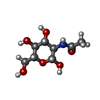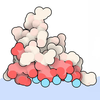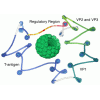[English] 日本語
 Yorodumi
Yorodumi- PDB-9mqe: Vitamin K-dependent gamma-carboxylase with Osteocalcin and vitami... -
+ Open data
Open data
- Basic information
Basic information
| Entry | Database: PDB / ID: 9mqe | ||||||||||||||||||||||||
|---|---|---|---|---|---|---|---|---|---|---|---|---|---|---|---|---|---|---|---|---|---|---|---|---|---|
| Title | Vitamin K-dependent gamma-carboxylase with Osteocalcin and vitamin K hydroquinone | ||||||||||||||||||||||||
 Components Components |
| ||||||||||||||||||||||||
 Keywords Keywords | TRANSFERASE / GGCX / VKGC / Vitamin K / VKCFD / Hemophilia B / Warfarin / Carboxylation / Blood Coagulation / Calcium homeostasis / Osteocalcin / MEMBRANE PROTEIN | ||||||||||||||||||||||||
| Function / homology |  Function and homology information Function and homology informationresponse to hydroxyisoflavone / hydroxyapatite binding / structural constituent of bone / peptidyl-glutamate 4-carboxylase / gamma-glutamyl carboxylase activity / negative regulation of testosterone biosynthetic process / cellular response to zinc ion starvation / negative regulation of bone development / response to macrophage colony-stimulating factor / Defective gamma-carboxylation of F9 ...response to hydroxyisoflavone / hydroxyapatite binding / structural constituent of bone / peptidyl-glutamate 4-carboxylase / gamma-glutamyl carboxylase activity / negative regulation of testosterone biosynthetic process / cellular response to zinc ion starvation / negative regulation of bone development / response to macrophage colony-stimulating factor / Defective gamma-carboxylation of F9 / vitamin binding / vitamin K metabolic process / regulation of testosterone biosynthetic process / response to vitamin K / negative regulation of neurotransmitter secretion / regulation of osteoclast differentiation / cellular response to vitamin D / regulation of bone mineralization / type B pancreatic cell proliferation / regulation of bone resorption / osteoblast development / response to vitamin D / response to zinc ion / positive regulation of neurotransmitter secretion / response to testosterone / response to gravity / bone mineralization / RUNX2 regulates osteoblast differentiation / response to mechanical stimulus / Transport of gamma-carboxylated protein precursors from the endoplasmic reticulum to the Golgi apparatus / Gamma-carboxylation of protein precursors / Removal of aminoterminal propeptides from gamma-carboxylated proteins / regulation of cellular response to insulin stimulus / response to glucocorticoid / protein maturation / response to activity / skeletal system development / stem cell differentiation / hormone activity / bone development / brain development / protein modification process / cellular response to growth factor stimulus / Golgi lumen / response to estrogen / cognition / cellular response to insulin stimulus / blood coagulation / osteoblast differentiation / glucose homeostasis / response to ethanol / perikaryon / vesicle / learning or memory / cell adhesion / response to xenobiotic stimulus / endoplasmic reticulum lumen / calcium ion binding / dendrite / endoplasmic reticulum membrane / structural molecule activity / extracellular space / extracellular region / membrane / cytoplasm Similarity search - Function | ||||||||||||||||||||||||
| Biological species |  Homo sapiens (human) Homo sapiens (human) | ||||||||||||||||||||||||
| Method | ELECTRON MICROSCOPY / single particle reconstruction / cryo EM / Resolution: 3.56 Å | ||||||||||||||||||||||||
 Authors Authors | Li, W. / Liu, B. / Cao, Q. | ||||||||||||||||||||||||
| Funding support |  United States, 7items United States, 7items
| ||||||||||||||||||||||||
 Citation Citation |  Journal: Cell Res / Year: 2025 Journal: Cell Res / Year: 2025Title: Structural insights into the vitamin K-dependent γ-carboxylation of osteocalcin. Authors: Qing Cao / Jianjun Fan / Aaron Ammerman / Samjhana Awasthi / Zongtao Lin / Saimi Mierxiati / Huaping Chen / Jinbin Xu / Benjamin A Garcia / Bin Liu / Weikai Li /  Abstract: The γ-carboxylation state of osteocalcin determines its essential functions in bone mineralization or systemic metabolism and serves as a prominent biomarker for bone health and vitamin K nutrition. ...The γ-carboxylation state of osteocalcin determines its essential functions in bone mineralization or systemic metabolism and serves as a prominent biomarker for bone health and vitamin K nutrition. This post-translational modification of glutamate residues is catalyzed by the membrane-embedded vitamin K-dependent γ-carboxylase (VKGC), which typically recognizes protein substrates through their tightly bound propeptide that triggers γ-carboxylation. However, the osteocalcin propeptide exhibits negligible affinity for VKGC. To understand the underlying molecular mechanism, we determined the cryo-electron microscopy structures of VKGC with osteocalcin carrying a native propeptide or a high-affinity variant at different carboxylation states. The structures reveal a large chamber in VKGC that maintains uncarboxylated and partially carboxylated osteocalcin in partially unfolded conformations, allowing their glutamate-rich region and C-terminal helices to engage with VKGC at multiple sites. Binding of this mature region together with the low-affinity propeptide effectively stimulates VKGC activity, similar to high-affinity propeptides that differ only in closely fitting interactions. However, the low-affinity propeptide renders osteocalcin prone to undercarboxylation at low vitamin K levels, thereby serving as a discernible biomarker. Overall, our studies reveal the unique interaction of osteocalcin with VKGC and provide a framework for designing therapeutic strategies targeting osteocalcin-related bone and metabolic disorders. | ||||||||||||||||||||||||
| History |
|
- Structure visualization
Structure visualization
| Structure viewer | Molecule:  Molmil Molmil Jmol/JSmol Jmol/JSmol |
|---|
- Downloads & links
Downloads & links
- Download
Download
| PDBx/mmCIF format |  9mqe.cif.gz 9mqe.cif.gz | 280.9 KB | Display |  PDBx/mmCIF format PDBx/mmCIF format |
|---|---|---|---|---|
| PDB format |  pdb9mqe.ent.gz pdb9mqe.ent.gz | Display |  PDB format PDB format | |
| PDBx/mmJSON format |  9mqe.json.gz 9mqe.json.gz | Tree view |  PDBx/mmJSON format PDBx/mmJSON format | |
| Others |  Other downloads Other downloads |
-Validation report
| Arichive directory |  https://data.pdbj.org/pub/pdb/validation_reports/mq/9mqe https://data.pdbj.org/pub/pdb/validation_reports/mq/9mqe ftp://data.pdbj.org/pub/pdb/validation_reports/mq/9mqe ftp://data.pdbj.org/pub/pdb/validation_reports/mq/9mqe | HTTPS FTP |
|---|
-Related structure data
| Related structure data |  48522MC  9mqbC  9mqcC M: map data used to model this data C: citing same article ( |
|---|---|
| Similar structure data | Similarity search - Function & homology  F&H Search F&H Search |
- Links
Links
- Assembly
Assembly
| Deposited unit | 
|
|---|---|
| 1 |
|
- Components
Components
-Protein , 2 types, 2 molecules AP
| #1: Protein | Mass: 87655.641 Da / Num. of mol.: 1 Source method: isolated from a genetically manipulated source Source: (gene. exp.)  Homo sapiens (human) / Gene: GGCX, GC / Cell line (production host): HEK293S / Production host: Homo sapiens (human) / Gene: GGCX, GC / Cell line (production host): HEK293S / Production host:  Homo sapiens (human) Homo sapiens (human)References: UniProt: P38435, peptidyl-glutamate 4-carboxylase |
|---|---|
| #2: Protein | Mass: 10975.558 Da / Num. of mol.: 1 Source method: isolated from a genetically manipulated source Source: (gene. exp.)  Homo sapiens (human) / Gene: BGLAP / Cell line (production host): HEK293S / Production host: Homo sapiens (human) / Gene: BGLAP / Cell line (production host): HEK293S / Production host:  Homo sapiens (human) / References: UniProt: P02818 Homo sapiens (human) / References: UniProt: P02818 |
-Sugars , 2 types, 5 molecules 
| #3: Polysaccharide | Source method: isolated from a genetically manipulated source #4: Sugar | |
|---|
-Non-polymers , 2 types, 3 molecules 
| #5: Chemical | | #6: Chemical | ChemComp-A1AVC / | Mass: 452.712 Da / Num. of mol.: 1 / Source method: obtained synthetically / Formula: C31H48O2 / Feature type: SUBJECT OF INVESTIGATION |
|---|
-Details
| Has ligand of interest | Y |
|---|---|
| Has protein modification | Y |
-Experimental details
-Experiment
| Experiment | Method: ELECTRON MICROSCOPY |
|---|---|
| EM experiment | Aggregation state: PARTICLE / 3D reconstruction method: single particle reconstruction |
- Sample preparation
Sample preparation
| Component | Name: Vitamin K-dependent gamma-carboxylase with Osteocalcin and vitamin K hydroquinone Type: COMPLEX / Entity ID: #1-#2 / Source: RECOMBINANT | ||||||||||||||||||||||||||||||
|---|---|---|---|---|---|---|---|---|---|---|---|---|---|---|---|---|---|---|---|---|---|---|---|---|---|---|---|---|---|---|---|
| Molecular weight | Value: 0.11 MDa / Experimental value: NO | ||||||||||||||||||||||||||||||
| Source (natural) | Organism:  Homo sapiens (human) Homo sapiens (human) | ||||||||||||||||||||||||||||||
| Source (recombinant) | Organism:  Homo sapiens (human) / Cell: HEK293S / Plasmid: pEG BacMam Homo sapiens (human) / Cell: HEK293S / Plasmid: pEG BacMam | ||||||||||||||||||||||||||||||
| Buffer solution | pH: 7.5 | ||||||||||||||||||||||||||||||
| Buffer component |
| ||||||||||||||||||||||||||||||
| Specimen | Embedding applied: NO / Shadowing applied: NO / Staining applied: NO / Vitrification applied: YES | ||||||||||||||||||||||||||||||
| Specimen support | Grid material: COPPER / Grid mesh size: 300 divisions/in. / Grid type: Quantifoil R1.2/1.3 | ||||||||||||||||||||||||||||||
| Vitrification | Instrument: LEICA EM GP / Cryogen name: ETHANE / Humidity: 95 % / Chamber temperature: 283.15 K |
- Electron microscopy imaging
Electron microscopy imaging
| Experimental equipment |  Model: Titan Krios / Image courtesy: FEI Company |
|---|---|
| Microscopy | Model: TFS KRIOS |
| Electron gun | Electron source:  FIELD EMISSION GUN / Accelerating voltage: 300 kV / Illumination mode: FLOOD BEAM FIELD EMISSION GUN / Accelerating voltage: 300 kV / Illumination mode: FLOOD BEAM |
| Electron lens | Mode: BRIGHT FIELD / Nominal magnification: 130000 X / Nominal defocus max: 2000 nm / Nominal defocus min: 1000 nm / Cs: 2.7 mm / C2 aperture diameter: 50 µm / Alignment procedure: COMA FREE |
| Specimen holder | Cryogen: NITROGEN / Specimen holder model: FEI TITAN KRIOS AUTOGRID HOLDER / Temperature (max): 77 K / Temperature (min): 63 K |
| Image recording | Electron dose: 47 e/Å2 / Film or detector model: GATAN K3 BIOQUANTUM (6k x 4k) / Num. of grids imaged: 1 / Num. of real images: 7089 |
| EM imaging optics | Energyfilter name: GIF Bioquantum / Energyfilter slit width: 20 eV |
| Image scans | Width: 4092 / Height: 5760 |
- Processing
Processing
| EM software |
| ||||||||||||||||||||||||||||
|---|---|---|---|---|---|---|---|---|---|---|---|---|---|---|---|---|---|---|---|---|---|---|---|---|---|---|---|---|---|
| CTF correction | Type: PHASE FLIPPING AND AMPLITUDE CORRECTION | ||||||||||||||||||||||||||||
| Particle selection | Num. of particles selected: 1322129 | ||||||||||||||||||||||||||||
| 3D reconstruction | Resolution: 3.56 Å / Resolution method: FSC 0.143 CUT-OFF / Num. of particles: 150446 / Symmetry type: POINT | ||||||||||||||||||||||||||||
| Atomic model building | Protocol: OTHER / Space: REAL | ||||||||||||||||||||||||||||
| Refine LS restraints |
|
 Movie
Movie Controller
Controller




 PDBj
PDBj









